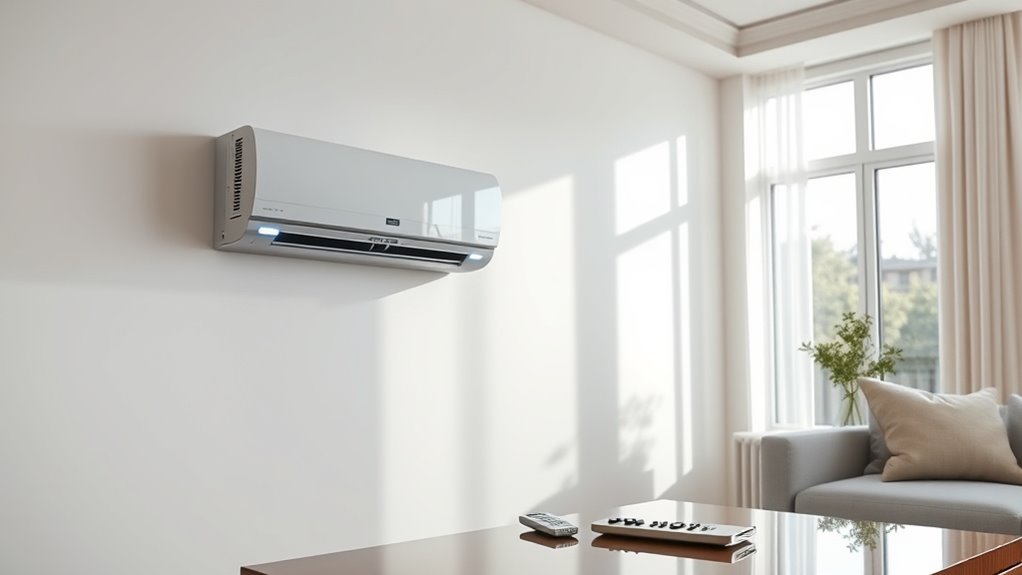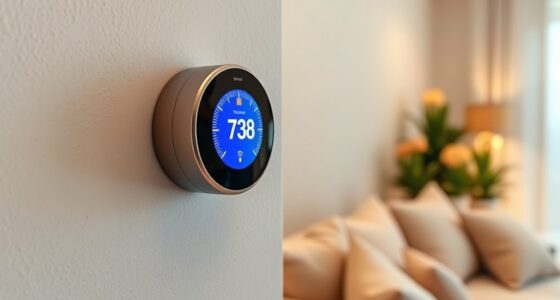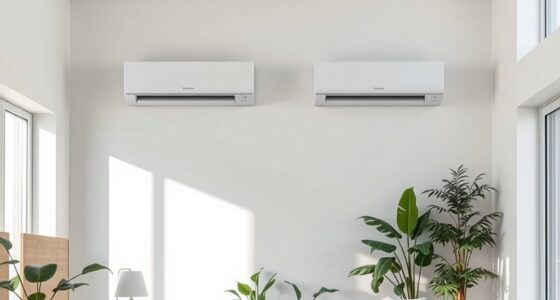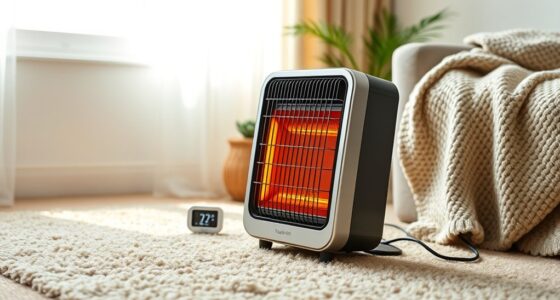Mini-split systems are quickly becoming the future of home cooling because they offer high energy efficiency, flexible installation, and precise climate control. You’ll enjoy targeted comfort with less energy waste and lower utility bills. Easy to install without ductwork, they’re perfect for retrofits or additions. Plus, they operate quietly and require minimal maintenance. Keep exploring to discover how these versatile systems can transform your home comfort and save you money over time.
Key Takeaways
- Mini-splits offer high energy efficiency and targeted cooling, reducing overall energy consumption and supporting sustainable living.
- Their flexible installation options make them ideal for retrofitting older homes and adding climate control to various spaces.
- Inverter technology ensures precise temperature regulation and quieter operation, enhancing comfort and convenience.
- Lower maintenance costs and long-term energy savings position mini-splits as cost-effective future home cooling solutions.
- Their eco-friendly features and adaptability make mini-splits a forward-looking choice for efficient, customizable climate control.
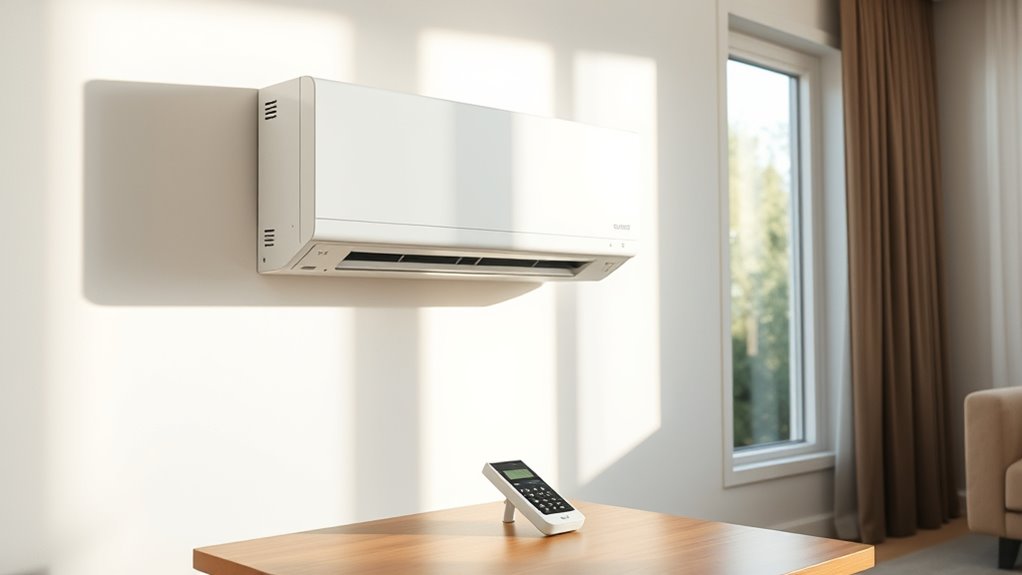
Mini-split systems are a versatile and energy-efficient way to heat and cool specific areas of your home or office. Unlike traditional HVAC systems that rely on ductwork, these units provide targeted climate control without wasting energy through leaks or inefficiencies in duct insulation. Because of their design, mini-splits can deliver high energy efficiency, helping you save on your monthly utility bills. When considering installation costs, you’ll find that mini-split systems often require a higher upfront investment compared to window units or portable ACs, but the energy savings and long-term benefits typically outweigh the initial expense. Installation is generally straightforward, especially since mini-splits don’t need extensive ductwork, making them a more affordable choice in terms of labor and materials.
Once installed, mini-split systems operate quietly and efficiently. They use inverter technology, which adjusts the compressor speed to maintain a consistent temperature, reducing energy consumption and providing more precise climate control. This technology makes them an excellent choice if you want to minimize your carbon footprint or simply lower your energy bills. Because they are zoned units, you can control the temperature in individual rooms or areas, avoiding unnecessary cooling or heating of unoccupied spaces. This zoning capability increases overall energy efficiency, as you only use energy where and when you need it.
Another advantage of mini-split systems is their flexible installation options. They are ideal for retrofitting older homes without ductwork or for adding air conditioning to converted spaces like garages, basements, or additions. The outdoor unit can be mounted on a wall or ground, and the indoor units are compact and unobtrusive, blending seamlessly with your decor. The initial installation costs may seem higher, but you save over time through reduced energy consumption and maintenance costs, which are typically lower for mini-splits compared to traditional systems. Additionally, mini-split units often feature versatile installation options, making them suitable for a wide range of building types and configurations.
Frequently Asked Questions
How Do Mini-Split Systems Compare to Traditional Central AC Units?
When comparing mini-split systems to traditional central AC units, you’ll find mini-splits often offer better energy efficiency since they allow you to cool only specific areas. The cost comparison can vary; mini-splits typically have higher upfront costs but save you money on energy bills over time. You’ll appreciate their flexibility and easier installation, making them a smart choice for targeted cooling and reducing your overall energy consumption.
Are Mini-Split Systems Suitable for Large or Multi-Story Homes?
You can definitely consider mini-split systems for large or multi-story homes because of their multi zone efficiency and ductless versatility. They allow you to cool different areas independently, saving energy and increasing comfort. While installing multiple units might be necessary, their flexibility makes them suitable for various home sizes. Overall, mini-split systems provide an effective cooling solution, especially if you want targeted control without extensive ductwork.
What Is the Typical Lifespan of a Mini-Split System?
Think of a mini-split system as a reliable companion that can keep working steadily for 10 to 15 years. Its energy efficiency is like a well-tuned engine, saving you on utility bills, while its durability offsets initial installation costs. With proper maintenance, this silent workhorse can serve your home comfortably over the years, making it a smart investment that balances long-term savings with consistent performance.
Can Mini-Split Systems Be Installed in Existing Homes Easily?
You can typically install mini-split systems in existing homes easily, thanks to their portable installation and retrofit options. They require minimal ductwork and can often be mounted on walls or ceilings without major renovations. This flexibility makes them ideal for upgrading your current cooling system quickly and efficiently. You won’t need extensive modifications, so you can enjoy improved comfort without the hassle of traditional HVAC replacements.
Do Mini-Split Systems Require Special Maintenance or Repairs?
You don’t need to worry about complex maintenance with mini-split systems. Regular routine checkups help guarantee they’re running efficiently, and you might need a refrigerant recharge if cooling performance drops. Unlike traditional systems, mini-splits are generally low-maintenance, but scheduling professional inspections helps catch potential issues early. Keep up with these simple steps, and your mini-split system will keep your home comfortable for years to come.
Conclusion
Mini-split systems are shaping up to be the wave of the future, offering efficient, flexible, and eco-friendly cooling solutions. As you consider your options, remember that these systems are like a breath of fresh air—bringing comfort directly to where you need it most. Embracing mini-splits means you’re not just cooling your home; you’re stepping into a smarter, greener way to live. The future of home cooling is clear, and it’s within your reach.
